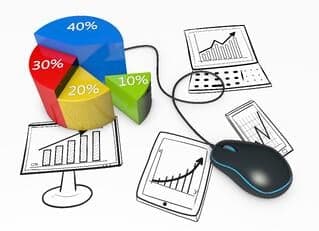Our website is designed to be more than a pretty online space. Our Facebook is more than a random series of posts. The words in our blogs are intentional.
 We’ve been successful with our online branding and marketing efforts because we’ve taken two key steps. First, we’ve taken the time to really understand the technology behind these tools so we can leverage them more effectively for our organization. Second, we keep a keen eye on the analytics that can help us make better moves and accomplish our business goals.
We’ve been successful with our online branding and marketing efforts because we’ve taken two key steps. First, we’ve taken the time to really understand the technology behind these tools so we can leverage them more effectively for our organization. Second, we keep a keen eye on the analytics that can help us make better moves and accomplish our business goals.
Calculated Results
Our social media and online marketing efforts are calculated. Here’s a glimpse into what I mean:
- More than a pretty website. Sure, aesthetics are important to draw interest and appeal. But the value of our website is what’s happening behind the scenes. We set it up to be more than a brochure that tells viewers what we do. We’re focused on capturing leads, helping viewers take the next step in the sales cycle and generating sales from it. The backend and integration with tools like HubSpot is what I think is most impressive about our website.
- Intentional words behind the blog. We choose the words in our technology blogs. We want to deliver value with each blog. We’re also focused on including keywords that people may be typing into Google or another search engine. So when they do, they find us. Each blog includes a “call to action” that helps interested readers take the next step and enables us to turn page visits into business leads. We’re leveraging keywords according to Google, meta tags and other search engine optimization techniques.
Metrics That Matter
On a weekly basis (and probably more), we have people pulling the data, analyzing it and when appropriate, making recommendations for adjustments to our strategy. Here’s a look at some metrics we’re watching that may surprise you:
- Website: While we do care about the number of visits and page views on our website, we’re honed in on form submissions because they turn a reader into a prospect.
- Blogs: Views again matter here, but we’re really focused on how many of those views translate to leads and then how many of those leads turn into sales. We track the total number of each as well as the dollar value of the sales.
- LinkedIn: We go beyond the number of connections and how optimized each profile is. We’re tracking the social selling index of our organization as a whole and of the sales professionals on our team who are using it to drive business. (Get your score for free here).
- Facebook: We want to continue to grow our followership and reach of our Marco Facebook Page. Even more important is the number of people we engage weekly and how that compares to the number of followers we have by percentage.
- Twitter: Link clicks matter most to us here because we want to drive people to our website to read our blogs. It’s easier to scan, like or even retweet a post on Twitter. Getting clicks shows a high level of engagement and interest.
As I shared recently, we believe in managing by metrics, not feelings and modern tools like Facebook, Twitter and HubSpot make that easier for organizations.
It’s not enough to use the tools. You have to really understand how they work and then figure out if they’re working for you. If they’re not, then you should adjust or stop using them altogether.
